The role of the Burgundian knight Jacques de Lalaine in suppressing the uprising in Ghent of 1452-1453
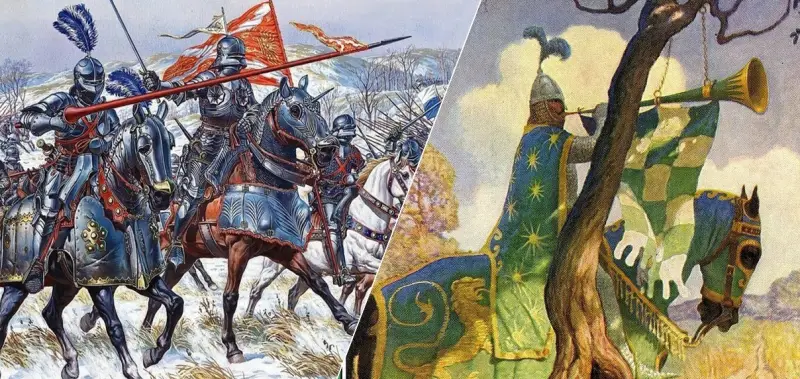
Revolt in Ghent 1452-1453 is one of the most important events in stories Duchy of Burgundy in the 1452th century. Urban uprisings were by no means uncommon in that era, including in the state created by the Dukes of Burgundy and which included highly urbanized regions such as Flanders. Nevertheless, the uprising in Ghent (open hostilities began only in the spring of 1447, but the actual confrontation between the duke and the city authorities began in 1) became a real struggle for the existence of the Burgundian Principate [XNUMX].
The Burgundian branch of the Valois took control of Flanders after the defeat of the Ghent militia at Roesbeek on November 27, 1382, but the city and its allies continued to be a problem for Philip the Bold and his descendants. Uprisings in Bruges, Rotterdam, Amsterdam and Leiden in 1437-1445 forced the Dukes of Burgundy to regularly take on weapon. Conflicts were usually resolved either by the duke himself or through an alliance with the local oligarchy, but in the case of Ghent the situation escalated into a protracted bloody war [2].
One of the active participants in this war was the knight errant Jacques de Lalen, a cult character in Burgundian literature of the 15th century, a truly legendary personality. It was on the battlefields of the war with Ghent that he found his death.
It should be noted that there are not many sources in Russian that describe the uprising in Ghent, much less the role of Jacques de Lalaine and his uncle Simon de Lalene in its suppression. First of all, this is the book by Renat Aseinov “At the Court of the Dukes of Burgundy. History, politics, culture of the 15th century,” as well as Vadim Senichev’s book “The Last Knight Errant.”
Ghent Uprising: causes and development of the conflict
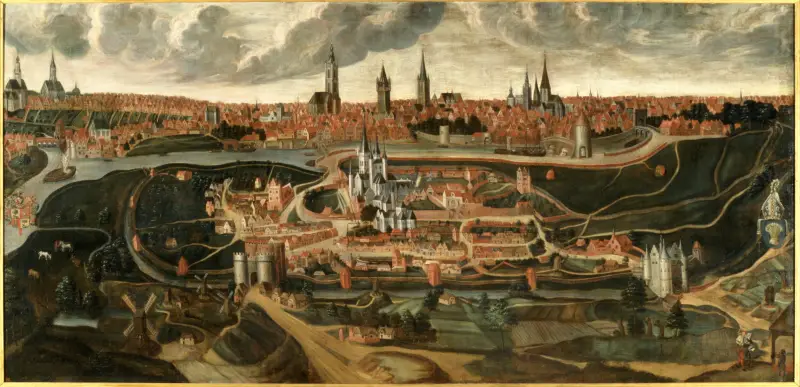
View of the city of Ghent in 1540, painting by Lucas de Heere
Before we begin to describe the direct participation of Jacques de Lalaine in the suppression of the uprising in Ghent, we should talk about the background to this conflict and how it developed.
In the middle of the 3th century, the Duchy of Burgundy was a federation of lands and principalities located on the territory of France and the Holy Roman Empire. Each of the regions that were part of Burgundy had both national identity and its own administrative structure. Struggling with the centralizing policy of the French kings, the Dukes of Burgundy themselves centralized their possessions. Starting with Philip the Good, the Burgundian dukes began to subordinate local government to their governors, who headed the Small Councils of the Lands. Small councils were subject to the decisions of the Grand Council and the Estates General, a legislative body with class representation [XNUMX].
In the 36th century, Flanders was a region with a fairly high degree of urbanization: 1% of the county's population lived in cities. According to this indicator, it can only be compared with Northern Italy. At the same time, an important feature was the dominance of two cities - Ghent and Bruges - which extended their power to adjacent rural areas, granting peasants, the so-called “external townspeople”, class rights of burghership [XNUMX].
Ghent during this period was considered the most influential city in the county. As the chronicler Mathieu d'Ecouchy writes, it was an unusually large, populous, very rich and most powerful city of all that were located on the lands of the duke [4]. The Burgundian chronicler Georges Chatelain also points to the special position of Ghent in Flanders, noting that without the consent of the city, the duke could not collect taxes in this county [1].
The privileges of Ghent seemed like abuses to Duke Philip the Good and the members of the Great Council. For this reason, the Duke decided to deprive the city of some of its privileges, which, of course, could not but cause a negative reaction from the townspeople. In addition, Philip the Good tried to influence the results of the elections in Ghent in order to prevent the election of candidates hostile to him to the city council. However, his attempts were unsuccessful.
Most chroniclers cite the main reason for the outbreak of the uprising in Ghent as the attempt of Philip the Good to introduce a permanent tax on salt throughout the county in 1447. Although the chronicler Thomas Basin, writing twenty years after the war, noted that the war could not have started just because of the tax, since after the victory the Duke never introduced it [2].
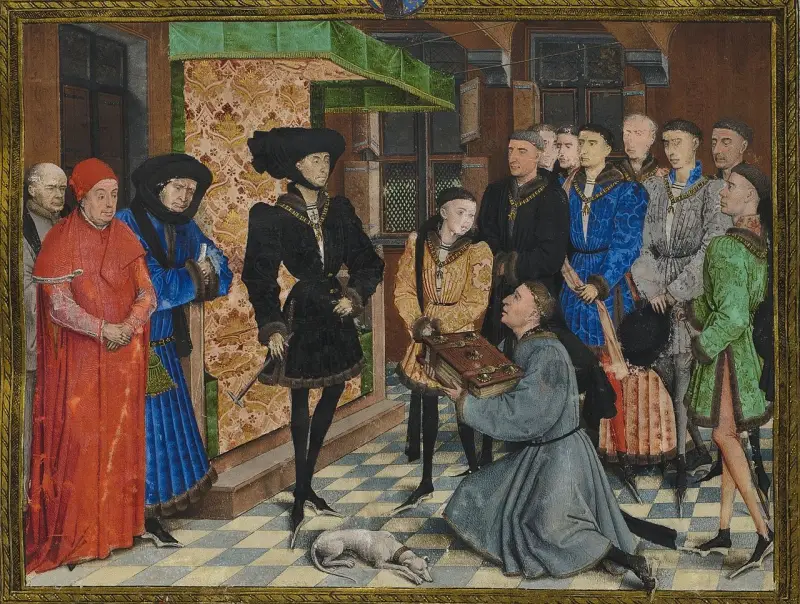
Philip the Good, accompanied by his son Charles and chancellor Nicolas Rolin c. 1447 (from the manuscript of the Chronicle of Hainaut)
Another extremely important cause of conflict was the rights and privileges of the city, discussed above. The only author who wrote openly about this is the chronicler Mathieu d'Ecouchy. He noted that Ghent enjoyed certain privileges that seemed excessive to the Duke and members of his council. Thus, the conflict between Philip the Good and Ghent was caused not only by the desire to introduce a tax on salt, but also by his desire to put an end to the political autonomy of the city [1].
Although Philip the Good's attempts to fight urban liberties ultimately led to the Ghent Uprising, in most cases he was able to compromise with his subjects and take their interests into account. It was for this reason that he could count on the support of other counties.
During the winter of 1451-1452, the inhabitants of Ghent expelled the administrators, who were gradually leaning towards the side of the duke. First, in October 1451, two of Philip's representatives were accused of trying to seize power, and in November they were executed despite the fact that the duke withdrew his bailiff from the city [2]. And in December, several more representatives of the Duke of Burgundy were beheaded.
In this situation, Philip the Good decided (like Louis of Male once) to resort to a trade blockade of the city. The blockade showed the successes of the Burgundian dynasty achieved in domestic and foreign policy: almost all subjects of Philip the Good both in Flanders (who rebelled against the duke individually in other situations) and in the rest of the Burgundian possessions in the Netherlands remained loyal to their lord and participated in the blockade of Ghent on land and at sea [5].
Residents of Ghent tried to find support from other cities, primarily Bruges and Liege, but did not receive it [5]. Trying to prevent a complete blockade of the city, the Ghent militia decided to besiege the Odenarde fortress, located south of Ghent and capable of controlling the movement of ships along the Scheldt. The garrison of the fortress was led by Simon de Lalen.
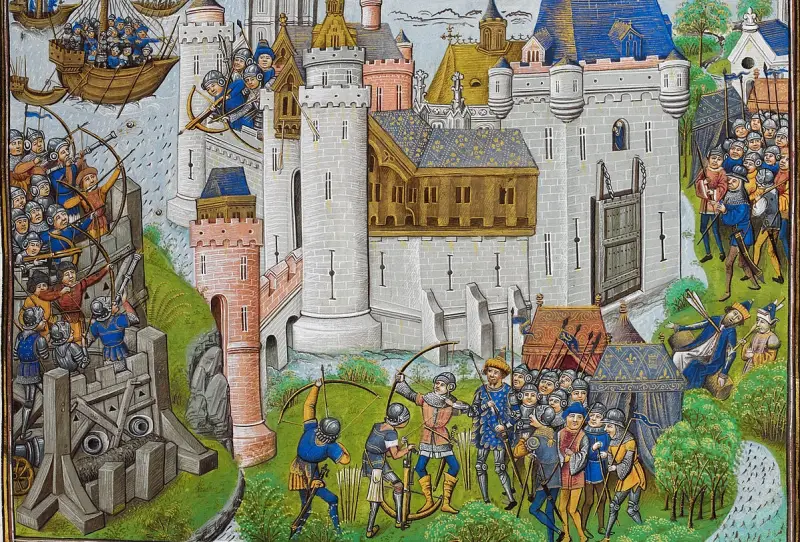
Miniature depicting the siege of the fortress of Mortagne near Bordeaux in 1377
The besiegers regularly used crossbows to throw messages into the city, written in French and Flemish, calling for surrender [2]. Simon de Lalen was also offered money for the surrender of the fortress. Moreover, the Ghent people even resorted to treachery. In particular, the chronicles indicate that they demanded that the besieged surrender the city in exchange for the lives of two children of de Lalen, allegedly taken prisoner (in fact, other children of the same age were given in marriage to them). However, Simon de Lalen ordered cannons to be installed against them, saying that let his children die, but “he will not lose his loyalty, honor and friends because of this" [five].
The Burgundian chronicler Olivier de Lamarche admires the action of Simon de Lalaine, contrasting the knight with the inhabitants of Ghent, who have no idea about the knightly code of honor [1].
Duke Philip the Good tried to strengthen the fortresses with new garrisons, and also, in full accordance with the logic of wars of the time, conduct raids on food supply routes and surrounding villages that could supply the city. In addition, the Duke, understanding the importance of the Odenarde fortress, tried in every possible way to help its defenders. The wandering knight Jacques de Lalen also hurried to help his uncle.
Jacques de Lalaine on the battlefields
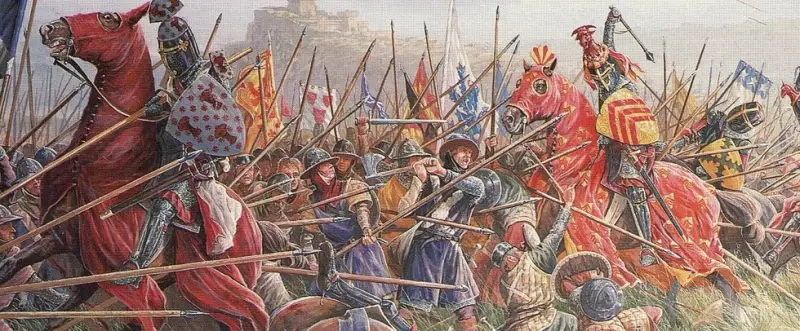
When news of the siege of Audenarde became known in Burgundy, Duke Philip's cousin, the Comte de Etampes, gathered under his command an army, mostly Picardians, which included a large number of Burgundian nobles. The Duke ordered this army to take the most convenient crossing across the Scheldt, leading from Picardy directly to Odenarde - the Espierre Bridge. Jacques de Lalen, wanting to come to the aid of his uncle Simon as soon as possible, begged the duke to let him go with the Count of Etampes, although initially he was supposed to accompany Philip the Good in his personal detachment [2].
The description of the battle on the bridge was preserved not only in Le livre des faits du bon chevalier messire Jacques de Lalain but also in the chronicle of Georges Chatelain. Moreover, in both cases, Jacques’ behavior is described as extremely heroic. If in his personal biography, written at the request of his father, such a description is natural, then the same praise in a more detached and neutral chronicle speaks of how good the knight errant really was in military affairs [2].
The Burgundians, having much smaller numbers than the Ghent militia, were able to inflict enormous damage on the enemy, both material and moral, lifting the blockade of the fortress in one day and demonstrating that knightly onslaught could still win battles.
In the spring of 1452, Jacques de Lalen and two other Burgundian knights, initiated members of the Order of the Golden Fleece, decided to conduct a deep raid on enemy territory with a detachment of about 400 people. It ended with an event known as the Battle of Lokeren, the main hero of which was “Good knight without fear and doubt».
During the assault on the town, the Burgundian riflemen and knights could not withstand the enemy counterattack and fled. At this moment, Jacques de Lalen showed composure. He and a small detachment held back the Flemings for some time, giving his comrades the opportunity to retreat. Five horses were killed under him, and the surviving Burgundians thought that he was dead.
Soon the Duke undertook a new expedition, which included Jacques de Lalen. On the way to Lokeren, he defeated one Ghent detachment, and in the battle of June 16 he saved the life of Jacques de Luxembourg, but was wounded in the leg [7].
In general, despite a number of setbacks, the Duke of Burgundy had the advantage on the battlefield. After a series of successful raids, attempts to conclude a truce began in May 1452 - the king of France acted as a mediator in negotiations between the duke and the rebellious city. The king's envoys were able to agree on a truce, which was to begin on June 27, but it was broken by Ghent the very next day.
As winter approached, the Duke decided to strengthen the garrisons around Ghent by sending his best knights to them. Jacques, in particular, led the garrison of Odenarde from January 4 to June 14, 1453. The Ghent people regularly raided villages and individual farms in Flanders, setting them on fire. The entire period from winter to June 1453 was spent in mutual attacks, but success for the most part accompanied the Burgundians [2].
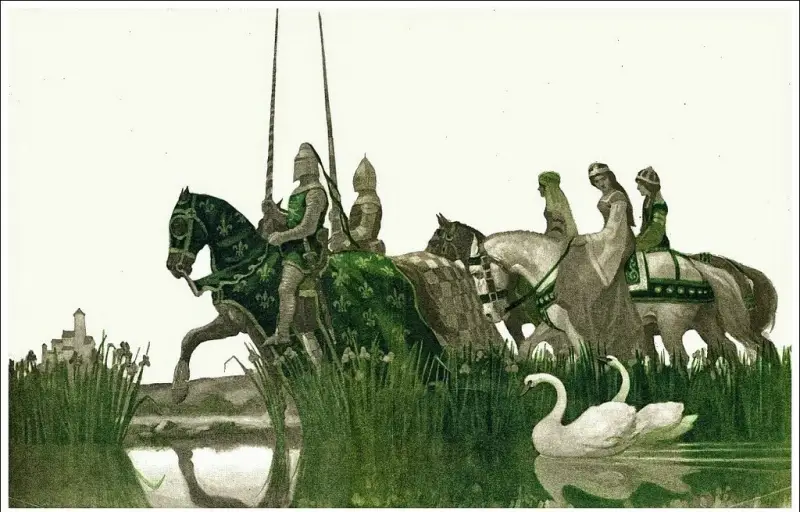
Painting by Newell Converse Wyeth
In the summer, Philip the Good decided to send troops to besiege Poke Castle, which was Ghent's key bastion in the West. However, Jacques de Lalen was ordered to first go to Odenhof Castle, also occupied by the rebels, and only then join the siege of Poke. Odenhof was abandoned by the rebels, but despite this, the Duke ordered the castle to be burned. Despite the fact that Jacques de Lalaine, as the chronicles note, reacted reluctantly to this order (he believed that there was no military need for constant arson), he carried it out.
Death of Jacques de Lalaine
Jacques joined the siege of the Poke fortress on July 3, 1453. After listening to the mass in the duke's tent, he confessed to the theologian Guy de Douzy, who was present with the duke, because the execution of the order to burn Odenhof weighed on him, and went to inspect the bombard that was firing at the castle wall. He was riding on horseback, because he had recently been wounded in the leg, and the wound had not yet fully healed. Herald Golden Fleece, who was nearby, suggested that Jacques return to camp and rest.
Jacques followed this advice, however, getting bored in the camp, at about 4 o’clock in the afternoon he decided to visit the herald again and headed under the walls of the castle. Not far from the fortress, he saw Adolf of Cleves, who was not far from the bombard, hiding behind a large wooden shield, and the bastard Duke Antoine, who were talking about something. Jacques dismounted and invited the herald to join their conversation [2].
And at that moment, as Vadim Senichev writes, Fortune changed the knight. All bombards shelling the fortress were dug in with deep trenches, which made it possible to hide from shelling, but this particular bombard was not dug in. It was protected in front by a large shield (mantelette), and at the edges there were two pavezes. A shot from the side of the fortress hit the shield behind which Jacques stood, and a fragment of the board blew off the right side of his head above the ear. This is how the knight errant Jacques de Lalen died.
Despite the fact that de Lalen was considered by his contemporaries to be a model of chivalry, his death is often described by some historians as allegedly unworthy of his status. For example, Johan Huizinga wrote the following in his classic work “Autumn of the Middle Ages”:
In fact, it is difficult to agree with such statements, since the troops of the Dukes of Burgundy were famous for their artillery and tactical decisions that corresponded to the changes that were taking place. As Vadim Senichev rightly noted:
As for the uprising in Ghent itself, the duke’s competent policy, as well as the lack of solidarity between the cities due to increasing rivalry, contributed to the fact that the uprising was suppressed by Philip the Good without attracting any outside help.
Использованная литература:
[1]. Aseynov R. M. At the court of the Dukes of Burgundy. History, politics, culture of the 2019th century / R. M. Aseynov - “Russian Foundation for the Promotion of Education and Science”, XNUMX.
[2]. Senichev V.E. The Last Knight Errant. – M.: Veche, 2023.
[3]. Kurkin A.V. Knights: the last battles - St. Petersburg: Polygon Publishing House LLC, 2004.
[4]. Escouchy M. d'. Chronique/ed. G. du Fresne de Beaucourt. Vol. IP 368-369.
[5]. A. A. Maizlish. Urban solidarity: reaction to urban uprisings in the Netherlands in the 12th - mid-4th centuries // News of Saratov University. New episode. Series History. International Relations, Volume 2012, Issue XNUMX /XNUMX.
[6]. La Marche O. de. Memoires. Vol. II. P. 233.
[7]. Loise F. Lalaing (Jacques de) // Biographie nationale de Belgique. T. XI. — Bruxelles: Bryant-Christophe et Cie, 1890-1891.
[8]. Huizinga Johan. Autumn of the Middle Ages / Comp., preface. and lane from the Netherlands D. V. Silvestrov; Commentary, indexes by D. E. Kharitonovich. – St. Petersburg: Ivan Limbach Publishing House, 2011.
Information